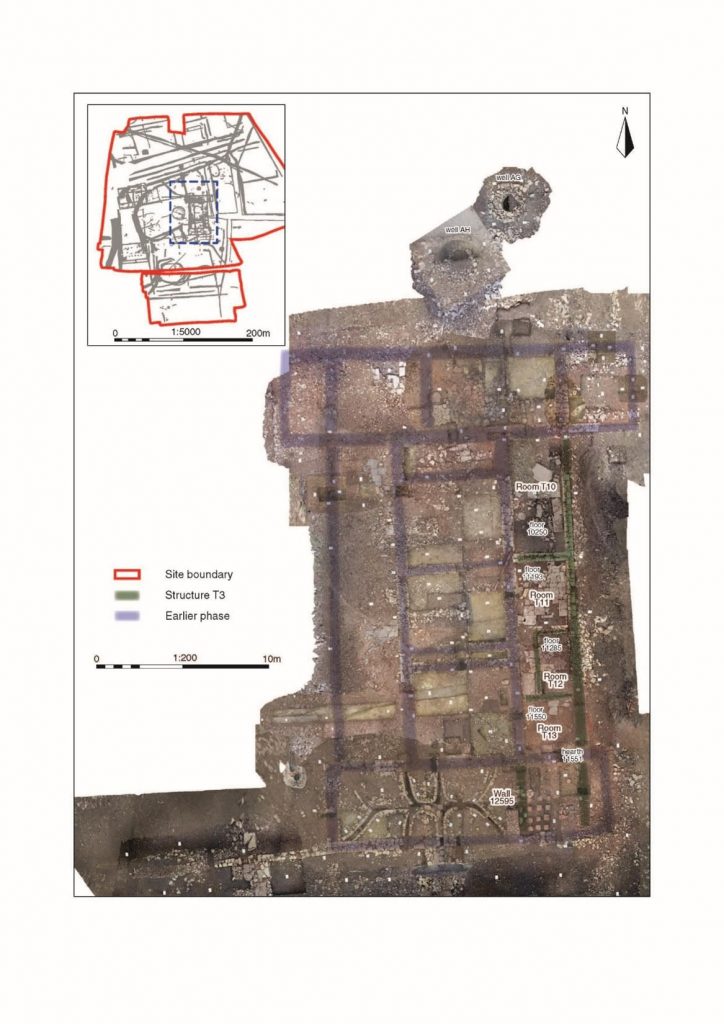
The villa is situated in the north of Lockleaze, Bristol, right next to the railway between Temple Meads and Bristol Parkway, and not far from the Ministry of Defence complex at Abbeywood. It came to light prior to a housing development, having been a playing field and so free from previous invasive damage from deep ploughing or buildings. The excavation proved an excellent opportunity, partly because many villas have been explored long ago before current techniques and technologies were available and partly because the good fortune that a playing field covered pretty well the whole of the complex of buildings, and so the entire villa could be revealed.
The site had originated with an Iron Age settlement and evolved through the Roman period, until reaching its climax as a full villa, a period lasting until the early fifth century, and perhaps later.

Period one. Phase one. First century (up to 100 A.D.).
The settlement probably started mid first century as a typical roundhouse with a circular enclosed area to the west, presumably for stock. The pottery presented native characteristics.
A second phase followed before the end of the century, but without a great deal of change. A mysterious item appeared not far from the habitation in the form of two sizeable post holes for two large poles, possibly of a religious nature, but basically without known purpose.
Period 2. Roman Phase 2.1: 100–250 A.D.
This period saw significant change. Structures changed from circular to more rectilinear shapes. Different styles of brooches emerged. And amphorae sherds appeared together with mortarias imported from Gaul. These finds show that the settlement had become embedded in the trade network of the Roman world.
Phase 2.2: 250–350 A.D.
No trace was evident now of the roundhouse, and the general appearance became more recognisably Roman in character, as did the finds associated with it. The main building became a corridor type of villa, developing over time into a winged structure with rooms projecting forward at each end of the corridor shape. A Droveway for moving animals now appeared to the north of the complex.

Phase 2.3: 350–400 A.D.
The main building assumed its final form as a courtyard villa. Hypocausts for underfloor heating were provided in some rooms, together with box flues to conduct hot air up the sides of a room. Certain structures suggest a bath house, but not definitely so. And fragments of painted wall plaster and window glass point to greater sophistication. However, no mosaic flooring is evident. Another linear range of rooms were built behind and parallel with the original corridor structure. The material of the building came from limestone quarries in the south of Bath, some 17 miles away.
Generally the villa functioned at a more complex level. An aisled barn provided additional capacity for agricultural purposes. A well-built well was one of several. A droveway continued to extend along the northern boundary.

The villa clearly operated in the Roman monetary economy since 264 coins have been found, mostly of a late Roman Britain date. The last coins date from about 295 A.D. to about 400 A.D. which figures because the last known shipment of coinage from the continent was around this time.
A rich assemblage of finds included glass objects and an extensive range of metal items. A large amount of pottery, 9000 sherds, was found, totalling 104 kg. Curiously, some high status items of the first century were found – an unusual lamp, and a small quantity of Samian pottery of the Flavian period (69–90 6AD), all this dating to the Period 1 of the site before other Roman characteristics became evident. A collection of different kinds of brooches seemed, despite the variety, to come from the same workshop. Five burials, all adults, were found within the site boundary.
What kind of villa was the Lockleaze site? Probably at the bottom end of the range of buildings usually described as villas. It had no mosaics and its size was dwarfed by comparison with the Chedworth Villa at the top end of the range. How long did it survive? Probably into the early 400s A.D., as did a number of local sites such as Chedworth. It does not seem to go on into the Saxon period and yet there is intriguingly a Saxon cemetery only 400 m away.
(Summarised by Bev Knot)
